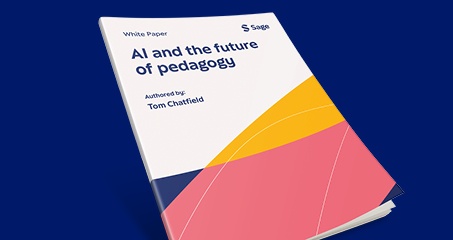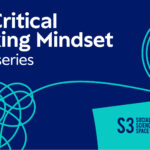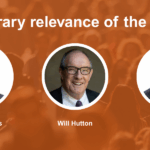What Kind of Moment Are We In?
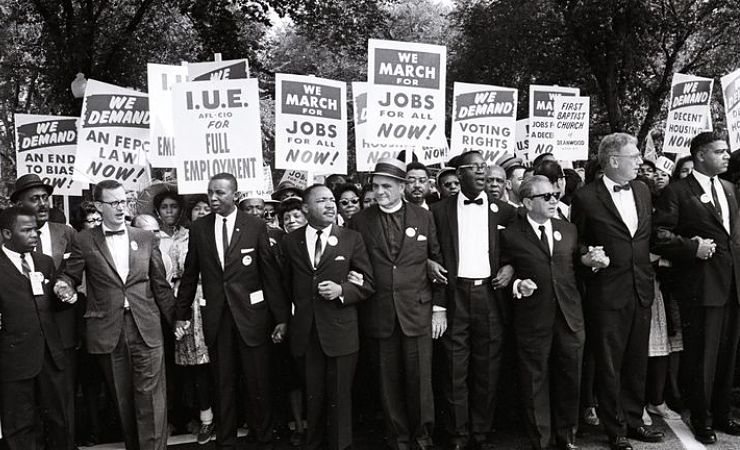
As tens of thousands of people were arriving for the March on Washington on August 23, 1963, Martin Luther King and other civil rights leaders huddled with John Lewis, then the chairman of the Student Nonviolent Coordinating Committee and now U.S. Representative from Georgia. They demanded that he change his speech.
“The revolution is at hand,” he was prepared to declare. “If…radical social, political and economic changes are to take place…the people…must bring them about.” In the draft of his speech he proposed to “crack the South into a thousand pieces and put them back together in the image of democracy.”
Pressured by King, by Robert Kennedy, and by prominent clergy who threatened to leave the stage if he went ahead with such confrontational rhetoric, Lewis and the other SNCC leaders relented. Lewis excised the remarks that would have broken the civil rights alliance of the moment (Garrow 1986).
In the current period, choices like these are being made every day: in Washington, D.C. and state capitals, in cities and towns mourning inexplicable deaths at the hands of police, and in countless conversations in which confrontation and conciliation are at odds. Choices like these will ultimately determine the trajectory of the current moment.
Like other observers of the sustained demonstrations triggered by the murder of George Floyd in Minneapolis on May 25 (and probably everyone who reads this essay), we wonder about their ultimate effect. Are we on the cusp of a vibrant social movement that will produce major transformations in our practices and policies? Or are we fated to see the communal expressions of grief and calls for change dissolve into contentious policy debates that may result in relatively modest reforms unequal to the fervent hopes now spinning in the streets?
It’s too early to tell. But from our lived experiences and our research on social movements we can offer some suggestions for thinking about the question.
There are many ways to think about social movements and their impact (e.g., McAdam, Tarrow, and Tilly 2001; Davenport, Nygård, Fjelde, and Armstrong 2019), and we are beholden to the multiple explorations of the concept and histories of its expressions. We are particularly interested in using what we know of earlier movements to provide some grasp of the present moment.
Here we understand social movements as a kind of collective action that transforms the relationships of people to society’s dominant institutions, and to each other. They are more organized and focused on future outcomes than fads and riots but more spontaneous and diffuse in their actions than interest groups and mass membership organizations. Although leadership is usually important, social movements are never fully led by a particular group or individual. Rather, a unique aspect of social movements as collective action is that their activities include spontaneous and undirected developments consistent with movement objectives — but not directed by central leadership (Freeman 1983, pp. 1-5). Even when there are designated leaders, their effectiveness generally depends on their capacity to listen and to be led by those whose voices they represent (Ahlquist and Levi 2011, 2013).
In the early sit-in stage of the civil rights movement, no national organization directed students to occupy segregated lunch counters. No organization directed sympathetic people in the North to picket the affiliates of national chains whose southern outlets were segregated. No central organization directed women to organize themselves into consciousness raising groups. Confederations of unions largely followed the creation of labor organizations by workers. The environmental movement was distinguished by the spontaneous outpouring of uncounted actions to clean up waterways and demand recycling. Local activist organizations were involved with all of these activities, but they were not directed through organizational hierarchies.
Every new action builds on a long legacy of protest. Some of us would date the origin of the modern civil rights movement to the lunch counter sit-ins of student activists in February 1960. But years before that many of these students were nurtured in their activism and trained for that moment by Ella Baker and others associated with the Highlander Folk School. Others would date the modern civil rights movement to the Montgomery bus boycott ignited by Rosa Parks in 1955. But two years before that, civic groups in Baton Rouge, Louisiana successfully boycotted the bus company (Morris 1984, pp. 17-9).
In the same spirit, the current outpouring of support builds on the actions of the Black Lives Matter leadership that dates back to 2013 (Lebron 2017). Black Lives Matter provided an organizing rallying-cry and inspiration, but hardly centralized leadership for the dispersed and far-flung activities being invented in diverse communities around the nation.
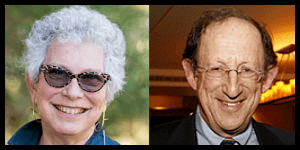
An interesting question in understanding the emergence of vigorous social movements is explaining why they develop in particular times, when seemingly nothing has changed in the underlying conditions. Systemic racism in the United States is not markedly different today than it was a year ago. And yet we wonder if we are on the cusp of enormous change. Why is a movement for social change erupting now, when underlying conditions have been relatively constant? We can offer a few thoughts.
First, it does not diminish the urgency of the moment or the actions we see around us to say that the murder of George Floyd took place just as many Americans were emerging from enforced isolation. Recent demonstrations may well have been the first time in two-and-a-half months that parents and their children were able and willing to get out of the house. People in the crowds likely had no conflicting appointments or invitations to other events.
Second, we agree with commentators who have observed that the demonstrations have also served as opportunities to speak out against the current U.S. president. Because he consistently aligns himself with right wing interests and advocates of white privilege, a stand for racial justice is a stand against him. Third, the death of George Floyd was not simply captured on video – it was vividly captured on video. In contrast to film of police shootings, the death was prolonged, devastatingly clear, and unambiguous. People of good will who are loath to criticize the police, or who would like to believe that there is “another side to the story,” are at a loss. There is no “other side of the story,” nor will there be. The clarity of the moment provides unprecedented support for demands for justice and police reform.
SOCIAL MOVEMENTS EMBRACE MULTITUDES
From the point of view of movement-building it is auspicious that in recent weeks people in small towns with tiny nonwhite populations have been demonstrating against systemic racism. It is auspicious that books on racial awareness have become best-sellers. It is meaningful that young white people, often with their young children, are coming out in support of Black Lives Matter. People who don’t think of themselves as political activists are joining in. These are the sorts of unexpected developments that signal at least the potential that the current outpouring of activism supports the notion that a transformative movement is in formation.
Such observations raise issues of whether the support of these and other movement “allies” will be steady, or fade. This approach to the question of sustainability is understandable but not a productive way to think about what’s going on. The notion of “allies” may be useful when there is a central group or organization in a leadership role, which then calls on sympathizers outside the organization for support. Think of workers in the Immokalee tomato fields in Florida, for example, or the vineyard workers organized by Caesar Chavez in California at an earlier time. Through their organizations, these workers developed campaigns to pressure growers by activating consumers to boycott Florida tomatoes or California grapes. In these cases, sympathetic consumers, or religious organizations that promoted the boycotts, might properly be called allies.
In the case of protest activity undertaken by relatively powerless groups, one can also think of allies as groups and individuals activated by the protests to exert influence on behalf of the protest objectives, even if they are not part of the group themselves. This dynamic was orchestrated by rent strike organizations in New York City in the 1960s, as one of us has described at length (Lipsky 1969).
However, the separation of outsiders with influence from insiders who animate the action is inconsistent with our understanding of the nature of social movements. As we understand social movements, people play varying roles according to their location in the social order, their degree of commitment, and the competition for their time. One neighbor attends actions in the city as often as possible, eventually graduating to a leadership role. Another makes masks to hand out to protestors. A third commits herself to learning more about racism and how she can act more effectively in her high school. The important point is that social movements are composed of large numbers of people playing different roles. They may be central to some actions and peripheral to others.
Inevitably, the intensity of social movements wanes. Political configurations transform. Movements may give way to interest groups or see their values incorporated in political parties that pursue the interests of the movements through conventional organized activities. Sometimes movements originating with commitments to popular participation drift toward oligarchy and their energies directed toward self-serving organizational maintenance. (Michels 1919 [1962]; Piven and Cloward 1977). Sometimes, the organizations sustain their commitments to the underlying cause, even as their tactics and strategies change.
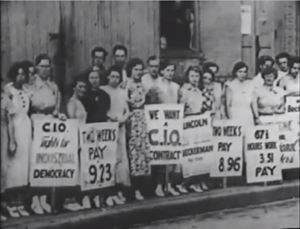
As times change and opportunities arise to represent movement objectives to authorities, movement organizations at times transition to speaking for people they have championed. In the 1930s the unions of the Congress of Industrial Organizations (CIO) mobilized workers in strikes, sit-downs, and other insurgent actions asserting their right to organize and bargain over the resistance of factory owners. The legal framework that resulted was a major victory for workers’ rights but within a structure that softened the militancy of the unions and constrained their activities (Levi, Melo, Weingast, and Zlotnick 2017). In the 1960s, the civil rights movement at local levels included multiple groups. Most were new, based in churches and student groups. Others, such as southern chapters of the NAACP, were decades old, but they exploded with a renewed energy and portfolio of actions (McAdam 1982). With the end of the movement, few of these groups were still standing, and those that were had reverted to playing by the given rules of the game.
FACTORS AFFECTING MOVEMENT LONGEVITY
Looking back, the movement will be judged by what concrete changes it left in its wake. Here public authorities will play a critical role in shaping the movement’s legacy.
As a movement for racial justice, informed by the egregious and seemingly unending examples of police misconduct, the movement may be long lasting. The well of racial injustice in America is very deep. It will never be fully plumbed and has virtually infinite capacity for continuing agitation and turmoil. Concrete proposals for change may arise, and so they should, because in part progress consists of authoritative commitments to change the status quo. But only the most profound of policy reforms can address the problems of racial injustice.
In addition, while public actions are critical to addressing issues of systemic racism, inequality can only fully be addressed when private actors, including corporations and religious institutions, interrogate their own activities and join the fight. From this point of view the demand for racial justice cannot readily be satisfied, however much we move as a society toward that goal. The theme of racial justice is fertile ground for ongoing action.
A movement primarily focused on police accountability, on the other hand, will have a harder time sustaining momentum. This is not to say that we don’t need police reform. But while police atrocities galvanize multitudes, reform of police practices invokes vigorous and passionate engagement by people from all parts of the political spectrum and ultimately requires negotiations for change that will challenge existing laws, contracts and customs. There is complexity at the heart of police reform, and antagonists ready to challenge a clear path toward change.
These realities partly explain why police reform is readily handed off to study groups, commissions, and blue ribbon panels, a development that historically supports the status-quo. (Lipsky and Olson 1977). These are the anterooms where zealous advocacy for social justice goes to die. From a movement perspective, the movement will be stronger the more it focuses on the open-ended theme of racial justice and the less it focuses on police policy.
The strength of the movement is in the continuing recruitment of participants to the transformative values that give it life. It is to inform public policy by giving rise to new constituencies with clearer demands and deeper commitments to change. At some point, like John Lewis, movement activists will be asked to tame their rhetoric and participate in the conventional ceremonies of politics. But for the potential of the movement that time should not be too soon.
References
Ahlquist, John S., and Margaret Levi. 2011. “Leadership: What It Means, What It Does, and What We Want to Know About It.” Annual Review of Political Science 14 (1):1-24.
———. 2013. In the Interests of Others: Leaders, governance, and political activism in membership organizations. Princeton: Princeton University Press.
Davenport, Christian, Håvard Mokleiv Nygård, Hanne Fjelde, and David Armstrong. 2019. “The Consequences of Contention: Understanding the Aftereffects of Political Conflict and Violence.” Annual Review of Political Science 22 (1):361-77.
Freeman, Jo. 1983. Social movements of the sixties and seventies. New York: Longman.
Garrow, David J. . 1986. Bearing the Cross: Martin Luther King, Jr. and the Southern Christian Leadership Conference. New York: William Morrow and Company.
Lebron, Christopher J. 2017. The Making of Black Lives Matter. New York: Oxford University Press.
Levi, Margaret, Tania Melo, Barry Weingast, and Frances Zlotnick. 2017. “Opening Access, Ending the Violence Trap: Labor, Business, Government, and the National Labor Relations Act.” In Organizations, Civil Society, and the Roots of Development, ed. Naomi R. Lamoreaux and John Wallis. Chicago: University of Chicago Press.
Lipsky, Michael, and David J. Olson. 1977. Commission politics : the processing of racial crisis in America. New Brunswick, N.J.: Transaction Books.
Lipsky, Michael. 1969. Protest in city politics; rent strikes, housing, and the power of the poor. Chicago: Rand McNally.
McAdam, Doug. 1982. Political process and the development of Black insurgency, 1930-1970. Chicago: University of Chicago Press.
McAdam, Doug, Sidney Tarrow, and Charles Tilly. 2001. Dynamics of Contention. New York: Cambridge University Press.
Michels, Robert. 1919 [1962]. Political Parties. New York: The Free Press.
Morris, Aldon D. 1984. The origins of the civil rights movement: Black communities organizing for change. New York: Free Press.
Piven, Frances Fox, and Richard Cloward. 1977. Poor People’s Movements. New York: Vintage Books.







